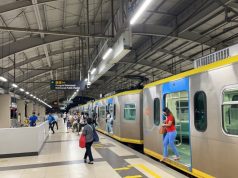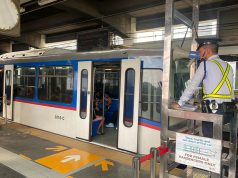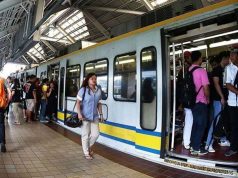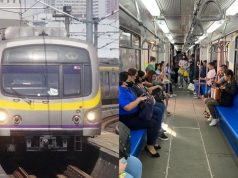MANILA, Philippines – How did the MRT-3 fail?
The Department of Transportation (DOTr) on Tuesday counted and explained the ways on how the National Capital Region’s 17-year-old rapid transit system – the lifeline of ordinary working Filipinos – became a mess.
According to DOTr Undersecretary for Rails Cesar Chavez, the root of the MRT-3 problem lies in the organizational structure of Metro Rail Transit Line 3 that up to now is composed of people who don’t have the expertise in operating and maintaining the train system.
“Ang sinasabi ko, ang puno’t dulo rito ay ang sistema at pagka-organize mismo ng MRT-3. Sa tingin namin, walang expertise ang DOTC, including the DOTC now, to operate and maintain MRT-3. Wala pa sa competence nila,” Chavez told the Senate Committee on Public Services chaired by Sen. Grace Poe.
Six engineers, one manager with discretionary powers
While the scope of work in the operation and maintenance of the mass rail system is huge, MRT-3 only has six engineers on board, prompting DOTr to hire 20 more, according to Chavez.
Another persistent problem is having only one general manager within a small project management office supervising a system that carries an average of 500,000 passengers daily.
To address this problem, Chavez said the DOTr was thinking of transferring the management and regulation of MRT-3 to the Light Rail Transit Authority and privatize its maintenance and operations.
The DOTr official said that through this set-up, MRT-3 would not be left at the mercy of a manager, who enjoys discretionary power, and would also be ensured of fiscal authonomy and inter-operability.
Making the problem worse is the transport system’s current maintenance provider Busan Universal Rail Inc. (BURI), which the DOTr claimed had allegedly failed to follow many provisions in its contract with MRT-3 that purportedly resulted in a series of technical glitches hounding the mass rail system.
Only 2 of 17 MRT-3 coaches overhauled
DOTr cited during the Senate hearing the 17 MRT-3 coaches that should have all been overhauled this month. However, the agency said that so far, BURI had only examined and repaired two carriages.
Chavez said BURI’s failure had prompted the DOTr to consider stopping the government’s maintenance project with the Filipino-Korean joint venture firm. He said the “series of derailment” of MRT-3 operations was already a good reason to “terminate” the Philippine government’s contract with BURI.
Also, the DOTr, during the Senate inquiry, complained about BURI’s alleged failure to purchase spare parts for the trains, which the agency said could have solved the frequent glitches bugging MRT-3.
The department explained before the Senate panel that this was the reason why it had decided to reduce payments to BURI so the company would be forced to buy spare parts for the trains.
BURI: MRT’s rail tracks are the main problem
But BURI protested the DOTR’s complaint against the firm. Company spokesperson, lawyer Charles Mercado, said during the hearing that BURI was able to provide all that it promised to MRT-3, adding that it was unfair for the department to put all the blame on its current maintenance provider.
According to Mercado, MRT-3’s railways tracks are the main problem because these are already defective and need to be replaced but this is not part of BURI’s scope of work.
“Masama talaga ang condition ng rails. May nailagay sa contract namin, if all gltiches were out of the condition of the rails, we will not be penalized. So pagka nagkaroon ng glitch arising from the rails…exempted kami,” said Mercado.
[The rails are really in a bad condition. There is a portion in our contract that says that if all the glitches were out of the condition of the rails, we will not be penalized. So if there would be glitches arising from the rails, we would be exempted.]
“Dapat hindi kami nabe-blame. We shouldn’t be penalized until the rail (replacement) is completed para wala nang nagsisisihan [We should not always be blamed. We should not be penalized until the rail replacement is completed so blaming would stop],” he added.
Missing bill of quantities, waste of public funds
But the DOTr countered that the government should not have awarded the contract to BURI because the previous DOTR’s Bidding and Awards Committee (DOTr) did not require the company to provide a bill of quantities that should have been the basis on what spare parts should be purchased for MRT-3.
During the Senate hearing, lawyer Catherine Gonzales, the DOTR undersecretary for procurement and administration during the Aquino administration, said there was a bill of quantities.
However, Gonzales said the staffers in-charge during the previous administration could not find a copy of the document that supposedly itemized the supplies, materials, parts, and labor needed for MRT-3.
The present DOTr leadership also accused the previous department BAC of wasting public funds because it had allegedly approved the purchase of new trains with fixed signaling system from Chinese companies Dalian Locomotive Corp. and Rolling Stock Company but afterwards also approved the government’s contract with BURI to replace the entire signaling system of the Dalian trains.
“Malaking pakakamali. Nag-procure ng Dalian train, bombardier ang signaling system. Isang taon matapos ang pagbili ng Dalian, pumasok sila sa isang kontrata sa BURI para sa total replacement of the signaling system,” said Chavez.
[It was a big mistake. Dalian trains with bombardier signaling system were procured. A year after the purchase of Dalian trains, they entered into a contract with BURI for the total replacement of the signaling system.]
Ex-manager washes hands of MRT-3 mess
Meanwhile, Al Vitangcol, the MRT-3 general manager during the Aquino administration, who also attended the Senate inquiry, washed his hands of the the mass transport mess.
He told the Senate panel that he should not be blamed for the change of MRT-3’s maintenance provider from Japan’s Sumitomo Corp. to PH Trams, which was allegedly the reason why the train system started to malfunction.
Sumitomo was the MRT-3 maintenance provider from 2000 to 2010. When its contract expired, the government did not renew it but only extended it for six months. It was replaced by PH Trams in 2012, which was incorporated just two months before winning the bid to become the maintenance provider for the transit system from October 20, 2012 to September 3, 2013.
Vitangcol claimed that after Sumitomo’s contract expired in 2012, he wrote to then Transportation Secretary Manuel “Mar” Roxas II requesting him to address the matter but the latter allegedly did not reply to his letter.
“I wrote a memo to Secretary Roxas through Director Cecile Natividad to…allow MRT Corp. to directly procure a maintenance provider for MRT. But the then DOTC never had the paper work done,” said Vitangcol.
Click and view the video report below:










